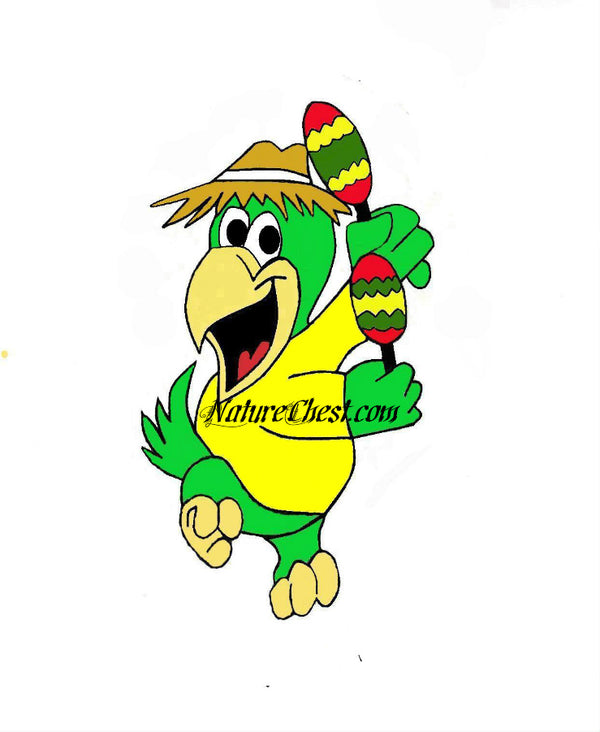It's All About the Beak
Share
PARROT BEAKS CAN BE SMALL OR LARGE, DARK OR LIGHT, OR EVEN YELLOW OR ORANGE



When climbing a beak almost becomes a parrot's third foot as they can use their powerful beak to hoist themselves up to their play gyms and cages, or even to just hang by their beak as they swing from their toys. Have you ever watched a parrot climb a ladder? The beak makes climbing around so much easier for them. They often use their beaks to help steady the finger or hand that reaches out to them as the first part of stepping up.
Those powerful beaks can be used to gently open the smallest seed to get at the wonderful nutrition inside. Ever watched a parrot close up picking up a seed, moving it around with their foot and their beak to get it situated in just the right spot for opening? Then using the foot, beak, and tongue, in unison they pry open the hull for the goodness inside. Or, just watch one of the big parrots rotating a big walnut to just the right place before cracking that hard nut as if it were made of the thinnest of shells. Then picking out the meat of the walnut with the tips of their beaks to make sure every little nugget of nutmeat is devoured.

Watch closely as your bird preens its feathers using the beak as a precision tool made for preening. Taking each feather with great care and running it through the beak removing all dust and debris for perfect feather condition. No matter if it is the tiny downy feathers that must be gingerly removed or the longest of the long tail feathers, that beak is the perfect tool for parrot preening and sharing the job with another feathered friend can be great fun too.

If you have ever been lucky enough to watch parrot parents feeding their young, it is the most touching of all. Although the parent beaks are huge compared to the tiny little babies, they are able to deliver food to their babies with the greatest of ease with no harm at all to the babies. The parents also use their beaks to gently nudge the babies into the perfect position under their adult feathers to keep them as warm as needed. To watch the gentleness of an adult parrot with its young is wondrous indeed.

But you may ask, what is this remarkable parrot beak made of? A beak consists of keratin which is the same material as animal's antlers are made of as well as your own fingernails. Just like your fingernails, a parrot's beak is continually growing. However, unlike a fingernail, a bird's beak also contains blood vessels and nerve endings.
Therefore a bird's beak is very sensitive to touch and also to injury. Some birds love to have their beaks gently rubbed by their favorite person, and some tend to be beak shy because the beak is so sensitive. A parrot's beak continues to grow all throughout a bird's life and in nature, birds are busy wearing the extra growth down with natural tree branches and foraging for their food. If you have a pet bird, you will want to provide lots of wooden toys of differing textures, both soft and hard wood, and possibly other materials, to help prevent overgrowth of the beak.
I have been asked quite often over the years "Why does my bird rub his beak on his perch so much?" There are a couple of reasons for this behavior. Birds often wipe their beaks on a perch to clean the beak, very often after a meal of soft foods, fruits, and vegetables. Another reason for wiping or rubbing the beak on a perch is an action to help smooth beak ridges or overgrowth layers. If you notice what looks like a "flaky" beak that is the layers of growth. New growth is underneath so birds rub their beaks against hard surfaces or rough textured surfaces to help remove the old beak layers on top. Providing multiple perch surfaces such as natural branches, textured surfaces, and sometimes grooming perches, will help your bird naturally remove the old layers of beak material.
Providing lots of wooden chew toys is a great way to help your bird control growth as well. Providing soft wooden toys for smaller birds, young juvenile birds, as well as many medium size birds, and both soft and hard woods for larger birds often does the job. So you see that wooden bird toy your bird buzz saws through is helping keep the beak worn down, and is as much a necessity for your parrot as any nutritious foods you provide for a healthy bird.
Trimming a bird's beak does not prevent biting, and it sure does not prevent the bite from hurting. Bird beaks can be gently filed down if needed, but should only be shaped or trimmed by someone who knows what they are doing as the beak can be damaged permanently by inexperienced groomers. Beaks should never be cut by anyone other than a vet or experienced bird groomer as excessive bleeding can occur if cut too short.
If your bird's beak severely overgrows or looks misshaped, even with lots of toys and chew items, you may need to have your bird health checked thoroughly by your avian vet to be sure there is not a health reason for the overgrowth.
Happy Beaking!
Debra

